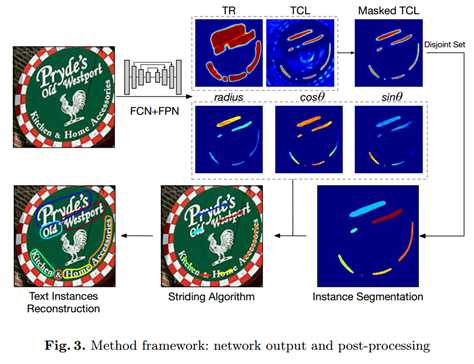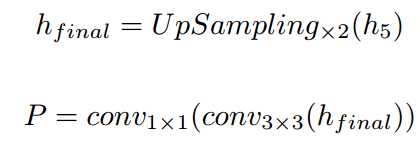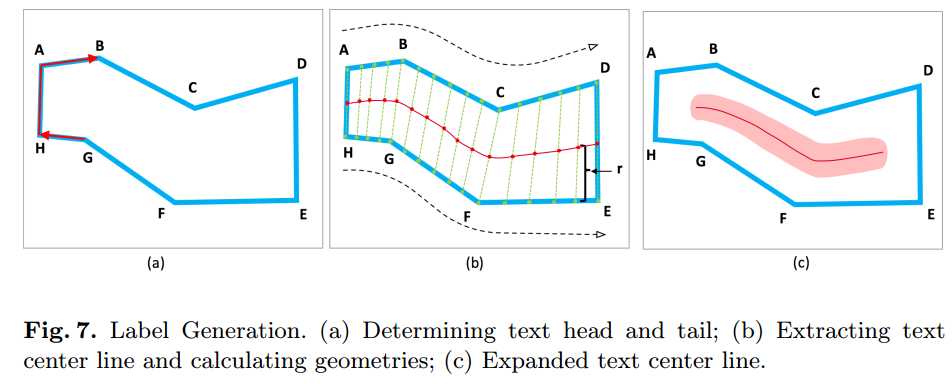标签:距离 dir 表示法 series 检测 相关 获得 try represent

文字检测,曲线文本,多方向,multi-stage,圆盘表示法
本文方法基于一个新的曲线文本表示方法TextSnake——用一个有序的圆盘序列来表示文字,先用FCN检测文本区域、文本中心线、以及每个点的圆盘半径、方向,然后利用文本区域mask和中心线mask得到text instance segmentation。在每个text-instance上,交替进行点中心化和点扩展,得到文本中心点序列。最后结合圆盘半径,得到文本区域的TextSnake表示并进行union得到最终的文本区域。

Fig. 1. Comparison of different representations for text instances. (a) Axis-aligned rectangle. (b) Rotated rectangle. (c) Quadrangle. (d) TextSnake. Obviously, the proposed TextSnake representation is able to effectively and precisely describe the geometric properties, such as location, scale, and bending of curved text with perspective distortion, while the other representations (axis-aligned rectangle, rotated rectangle or quadrangle) struggle with giving accurate predictions in such cases.
圆盘表示法
文本区域由多个互相覆盖的、有序的圆串联而成。故文本区域可以由一个圆序列来完全表示。

其中$D_i$表示第i个disk,n是圆的总个数。每个$D = (c, r, \theta)$,三个参数分别表示中心点、半径,以及圆盘角度。$r$是圆盘中心点所在的局部宽度(笔画宽度)的一半。$\theta$是经过中心点的曲线的切线的角度的正切值。
前两个很好理解,最后一个事实上,如果从直观角度,已知每个圆盘中心点坐标和半径,其实就已经确定了这个disk序列。之所以这里多加一个参数$\theta$是因为这里中心线上的点非常多(可以作为圆盘中心的),不可能每个点都求出一个圆盘(速度太慢),所以作者提出的方法是基于其中某个点来扩展下一个点。通过隔一段距离采样一个点的方式来得到整个中心文本线,而这个采样的step长度和方向就可以由$r$和$\theta$来共同决定。(个人觉得这个表示方法不太合理。即使没有$\theta$也是一个完整的表示法。$c$和$\theta$两个信息不但冗余甚至可能冲突)

Fig. 2. Illustration of the proposed TextSnake representation. Text region (in yellow) is represented as a series of ordered disks (in blue), each of which is located at the center line (in green, a.k.a symmetric axis or skeleton) and associated with a radius r and an orientation θ. In contrast to conventional representations (e.g., axis-aligned rectangles, rotated rectangles and quadrangles), TextSnake is more flexible and general, since it can precisely describe text of different forms, regardless of shapes and lengths.
检测步骤主要分为四个步骤。

仿照FPN和U-net设计的结构如下:

对应的操作运算公式如下:最后输出7个channel,4个channel表示logits of TR/TCL,另外3个channel对应text-instance的$$r, cos\theta, sing\theta$$。



和$sin\theta$)
output: 曲线文字区域
Step1-Act(a): 在instance-segmentation上随机取一点,将其中心化(利用法向量等将点移到过该点的笔画的中心位置),将中心化后的点作为圆盘中心线的第一个起点
Step2-Act(b): 以上一个点为中心点,向两边同时扩展(或者一边)。扩展方向和step大小为与半径$r$和$\theta$相关,公式如下:

Step3-Act(a):将扩展后的点进行中心化
Step4:重复Step2和Step3,直到整个圆盘中心线都扩展完成(超出instance-segmentation区域)
Step5-Act(c): 利用中心线+半径信息,进行重构得到最终输出

Fig. 5. Framework of Post-processing Algorithm. Act(a) Centralizing: relocate a given point to the central axis; Act(b) Striding: a directional search towards the ends of text instances; Act(c) Sliding: a reconstruction by sliding a circle along the central axis.

The two edges near the head or tail are running parallel but in opposite direction.
在每个边上撒点(均匀撒点)
取相对边的中点连线即为圆盘中心线

包括分类(TR和TCL)和回归($r$、$cos\theta$、和$sin\theta$)损失。



Fig. 8. Qualitative results by the proposed method. Top: Detected text contours (in yellow) and ground truth annotations (in green). Bottom: Combined score maps for TR (in red) and TCL (in yellow). From left to right in column: image from ICDAR 2015, TotalText, CTW1500 and MSRA-TD500. Best viewed in color.
曲文数据库(Total-Text和CTW1500)

倾斜文本数据库(ICDAR2015和MSRA-TD500)



这篇方法有意思的是提出用圆盘序列(TextSnake)来表示曲文,但是文中有多处其实有歧义或者说没有说清楚实际的具体方法,比如$\theta$和c的不互斥性、最后的重构方法、中心化的具体方法等等。应该说方法很有创新性,结果也比较好。
Shangbang Long_ECCV2018_TextSnake_A Flexible Representation for Detecting Text of Arbitrary Shapes
标签:距离 dir 表示法 series 检测 相关 获得 try represent
原文地址:https://www.cnblogs.com/lillylin/p/9955181.html